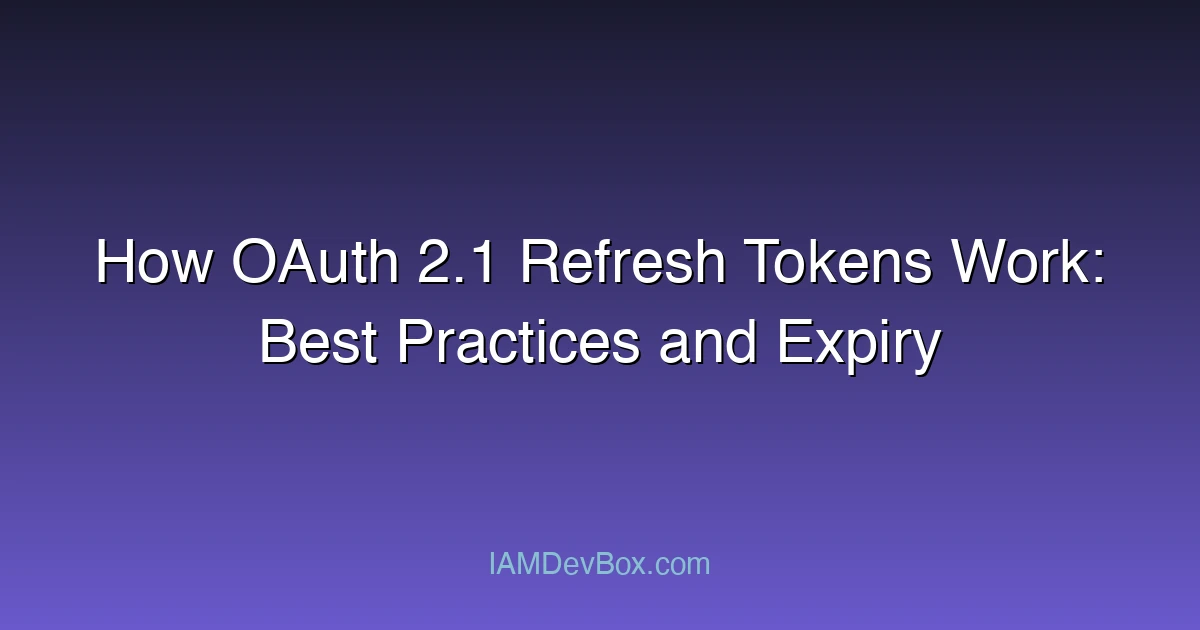Visual Overview:
sequenceDiagram
participant User
participant App as Client App
participant AuthServer as Authorization Server
participant Resource as Resource Server
User->>App: 1. Click Login
App->>AuthServer: 2. Authorization Request
AuthServer->>User: 3. Login Page
User->>AuthServer: 4. Authenticate
AuthServer->>App: 5. Authorization Code
App->>AuthServer: 6. Exchange Code for Token
AuthServer->>App: 7. Access Token + Refresh Token
App->>Resource: 8. API Request with Token
Resource->>App: 9. Protected Resource
OAuth 2.1 introduces refinements to enhance the security and usability of OAuth flows, especially around refresh tokens. Understanding how refresh tokens work in OAuth 2.1, their lifecycle, and best practices is essential for developers and security architects aiming to build robust authentication systems.
What Are Refresh Tokens?
Refresh tokens are long-lived credentials issued by the authorization server alongside access tokens. Their purpose is to obtain new access tokens without requiring the user to re-authenticate, enabling seamless user sessions.
OAuth 2.1 Updates to Refresh Tokens
OAuth 2.1 builds on OAuth 2.0 by:
-
Recommending refresh tokens be rotated on every use to prevent replay attacks.
-
Mandating the use of PKCE even for confidential clients, enhancing security.
-
Clarifying that refresh tokens should be securely stored and limited in scope.
-
Encouraging short-lived access tokens with refresh tokens as the secure renewal mechanism.
How Refresh Token Rotation Works
With rotation, each time a client uses a refresh token to get a new access token, the server issues a new refresh token. The previous refresh token is invalidated immediately.
1. Client sends refresh token to authorization server.
2. Server verifies token and issues new access and refresh tokens.
3. Old refresh token is revoked.
4. Client replaces stored refresh token with the new one.
This approach reduces risks if a refresh token leaks — stolen tokens quickly become invalid.
Managing Refresh Token Expiry
Refresh tokens can have absolute or sliding expiration:
- Absolute expiry: Token is valid until a fixed expiration date regardless of use.
- Sliding expiry: Token expiration is extended with each use, but up to a max lifetime.
Set expiry durations carefully balancing user convenience and security:
- Example: Access token lifetime 15 minutes; refresh token lifetime 14 days.
- Revoke refresh tokens upon suspicious activity or logout.
Security Best Practices
- Use Secure Storage: Store refresh tokens securely on the client (e.g., encrypted storage on mobile devices).
- Implement Token Binding: Bind refresh tokens to client properties or device identifiers.
- Use HTTPS only to transmit tokens to prevent interception.
- Employ Refresh Token Revocation: Allow users or admins to revoke tokens on demand.
- Monitor for Refresh Token Abuse: Detect abnormal usage patterns to identify leaks.
🎯 Key Takeaways
- Use Secure Storage: Store refresh tokens securely on the client (e.g., encrypted storage on mobile devices)
- Implement Token Binding: Bind refresh tokens to client properties or device identifiers
- Use HTTPS only to transmit tokens to prevent interception
- Employ Refresh Token Revocation: Allow users or admins to revoke tokens on demand
Implementing Refresh Tokens in OAuth 2.1
Most OAuth libraries now support refresh token rotation and PKCE by default. When implementing:
-
Always include PKCE even for confidential clients.
-
Validate refresh tokens strictly on the server side.
-
Handle errors gracefully, forcing user re-authentication if refresh fails.
-
Log refresh token issuance and revocation events for audit.
Example Refresh Token Request (cURL)
curl -X POST "https://auth.example.com/oauth2/token" \
-H "Content-Type: application/x-www-form-urlencoded" \
-d "grant_type=refresh_token&refresh_token=old_refresh_token_here&client_id=your_client_id&client_secret=your_client_secret&code_verifier=your_code_verifier"
Conclusion
OAuth 2.1 refresh tokens improve security and session management by enforcing rotation and stronger client protections. Adopting these best practices ensures secure, user-friendly OAuth implementations.
👉 Related:
Understanding the Authorization Code Flow with PKCE in OAuth 2.0
OAuth 2.0 Token Introspection: Real-Time Validation Explained
💡 How do you handle refresh token rotation and expiry in your OAuth implementations? Are there scenarios where longer refresh token lifetimes are justified?
